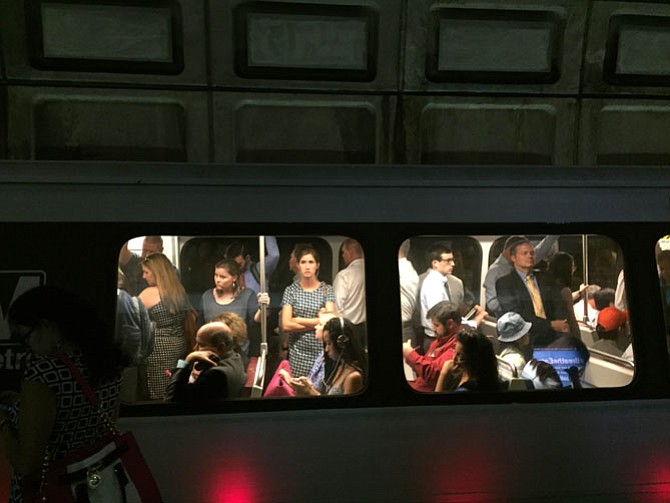Westbound Orange Line train. Photo by Vernon Miles.
“During each one of these surges, it’s good opportunity to rethink your commute. People will find there’s lots of viable routes, whether it’s a bus route or a shuttle, or even biking into work one day.”
— Yon Lambert, Director, Transportation and Environmental Services
July was rough for the metro in Alexandria, but the city has emerged through the worst of it. Between July 5 and 18, Surges 3 and 4 involved complete line shutdowns between Reagan National Airport and Braddock Road, then in the other direction between Reagan National Airport and Pentagon City. The latter didn’t take place in Alexandria, but kept commuters from using the Metro to get to Washington D.C.
In place of the Metro, Carrie Sanders, deputy director of Transportation and Environmental Services, said the city worked with other partners to supply alternate transportation.
“Virginia Railway Express (VRE) was essential during Surge 3 and Surge 4,” said Sanders. “The VRE saw an increase in ridership during those periods. For those that continued to use metrorail during the disruption, we had high frequency shuttles between Braddock Road and National Airport.”
But the reception to those shuttles was mixed. Many said the shuttles worked effectively when they were on time, but that there were often long delays where the buses were backed up.
Mike Navarro is an Alexandria resident who had just returned to the area from El Paso when the surges hit. Navarro said the worst part of the surges was seeing buses lined up to take people from one station or another, then seeing some of the buses unexpectedly pull away to change shifts or take a break. But overall, Navarro said he was impressed with the bus system.
“The buses were pretty good,” said Navarro. “We had very courteous drivers and they knew their stuff. I think I would use the buses more after this.”
“I thought the buses did a good job,” said Lena Chang, who takes the Yellow Line to L’Enfant Plaza. “We had to take the shuttle buses, but they were pretty well organized. The commute was longer, it’s usally about 30 minutes and during the surge it took an hour and 15 minutes, but they had people directing buses and the shuttles were ready to go.”
Yon Lambert, director of Transportation and Environmental Services, said the shuttles were run by the Washington Metropolitan Area Transportation Authority (WMATA),
“WMATA was very clear: the shuttle service was not going to fully replace service metrorail provides,” said Lambert. “That’s why WMATA, Alexandria, and Arlington offered different types of services during the surges. When you look at the numbers of people using the metro and the capacity of the [shuttle] bridge, it doesn’t add up… The sheer number of people to move was a challenge.”
Getting people from the Braddock Metro up to National Airport took a combination of taxis, bikes, and buses. Sanders said the city set a flat taxi fare of $15 between the Braddock Metro and the airport. The bike share at Braddock, already the busiest in Alexandria, was expanded. Lambert said the average monthly riders renting bikes at Braddock is 635, but the numbers had steadily been increasing during safetracking. In June, 957 trips departed from Braddock Road, while the numbers for July have not come in yet.
Metroway was the last alternative transportation that saw a major uptick during the Alexandria Surges. The bus service runs from the Braddock Road Metro through Potomac Yard up to Crystal City.
“We had a huge increase in Metroway ridership,” said Lambert. “Ridership was up 165-177 percent. Metroway carries upwards of 2,000 riders per day. People were using these transportation alternatives during the Surge.”
However, not everyone in the city converted to other forms of public transportation.
“Unfortunately, we saw some people that still chose to drive,” said Lambert. “Traffic was up on all the major roads that served the surge zone. During surge 3 and 4, congestion on Route 1, on the parkway, and on I-395 was up over 100 percent.”
Lambert said the delay wasn’t as bad during Surge 3, which occurred the week of Fourth of July, but the traffic was more noticeably congested during the Surge 4 work week. Despite the emphasis on alternative modes of public transportation, Lambert said the city still needed to prepare for increased traffic.
“We made sure that our traffic management center was fully staffed during surges 3 and 4,” said Lambert. “That’s on-site traffic engineers monitoring travel throughout the city to adjust signal time, if needed. We have traffic cameras out and were coordinating with the police department at key intersections.”
The next surge to impact Alexandria will be Surge 8, with single-tracking between Franconia-Springfield and Van Dorn Street. The last surge to impact Alexandria will be Surge 14 in January, with 24 days of continuous single-tracking from Braddock Road to the Huntington and Van Dorn
Sanders said the city’s plan for Surge 8 will be released shortly and says it may include increased bus service out to the Van Dorn and Eisenhower metro stations.
“During each one of these surges, it’s good opportunity to rethink your commute,” said Lambert. “People will find there’s lots of viable routes, whether it’s a bus route or a shuttle, or even biking into work one day.”


